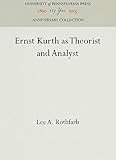Ernst Kurth as Theorist and Analyst / Lee A. Rothfarb.
Material type: TextSeries: Studies in the Criticism and Theory of MusicPublisher: Philadelphia : University of Pennsylvania Press, [2016]Copyright date: ©1989Edition: Reprint 2016Description: 1 online resource (264 p.) : 160 illusContent type:
TextSeries: Studies in the Criticism and Theory of MusicPublisher: Philadelphia : University of Pennsylvania Press, [2016]Copyright date: ©1989Edition: Reprint 2016Description: 1 online resource (264 p.) : 160 illusContent type: - 9780812275629
- 9781512806267
- online - DeGruyter
- Issued also in print.
| Item type | Current library | Call number | URL | Status | Notes | Barcode | |
|---|---|---|---|---|---|---|---|
 eBook
eBook
|
Biblioteca "Angelicum" Pont. Univ. S.Tommaso d'Aquino Nuvola online | online - DeGruyter (Browse shelf(Opens below)) | Online access | Not for loan (Accesso limitato) | Accesso per gli utenti autorizzati / Access for authorized users | (dgr)9781512806267 |
Frontmatter -- Contents -- Preface and Acknowledgments -- 1. Introduction -- 2. Fortspinnung -- 3. Developmental Motives -- 4. Polyphonic Melody -- 5. Kurth's Historical View of Harmony -- 6. Kurth's View of Romantic Harmony -- 7. Sensuous Harmony -- 8. Energetic Harmony -- 9. Kurth's Concept of Form -- 10. Conclusion -- Appendix: List of Musical Examples -- Bibliography -- Index
restricted access online access with authorization star
http://purl.org/coar/access_right/c_16ec
Ernst Kurth as Theorist and Analyst is the first book length study devoted to the writings of one of this century's most important music theorists. In contrast to previous discussions, Lee A. Rothfarb's study explains Kurth's theories in light of his analyses of specific musical examples.Unlike many of his contemporaries, Kurth approached music primarily from a cognitive rather than a purely technical viewpoint. In a unique kind of experiential analysis, he examined the psychological foundations of counterpoint, harmony, and form, and considered the affective, as opposed to solely structural or syntactic, effects of melody, chord, interval, and tone.The introduction provides a biographical sketch of Kurth, based on archival research and personal interview with his widow, son, and many of his doctoral students. Rothfarb also discusses the intellectual currents of the late nineteenth and early twentieth centuries, both musical and nonmusical, which shaped Kurth's outlook. Eight chapters summarize the main ideas of Grundlagen des linearen Kontrapunkts and Romantische Harmonik and show the directions Kurth took in his later works, Bruckner and Musikpsychologie. A final chapter identified his influence on several of his well-known contemporaries.Ernst Kurth as Theorist and Analyst will interest music theorists, musicologists, and advanced students of music theory.
Issued also in print.
Mode of access: Internet via World Wide Web.
In English.
Description based on online resource; title from PDF title page (publisher's Web site, viewed 27. Sep 2021)


